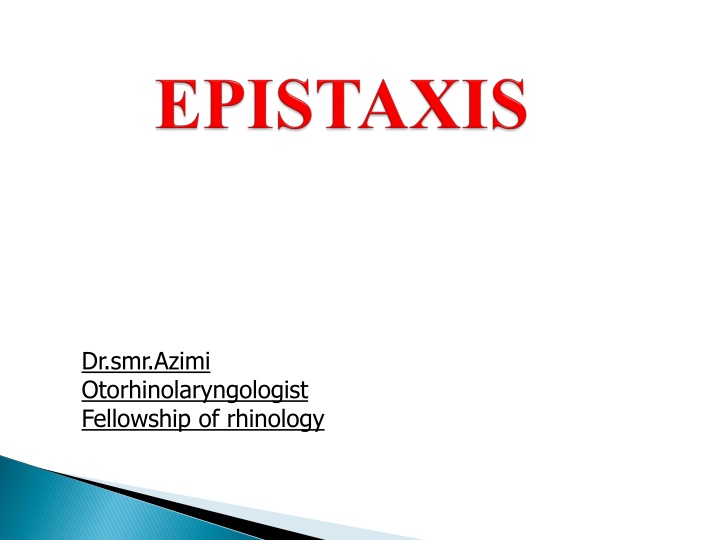
Nose Vascularity and Causes of Epistaxis
Explore the intricate vascularity of the nose and common causes of epistaxis (nose bleeding), including trauma, infections, idiopathic conditions, neoplasms, and miscellaneous factors. Delve into the detailed anatomy and potential triggers for nosebleeds, from local causes to systemic conditions. Gain insights on the different arterial and venous vessels in the nasal region, their anastomoses, and the implications for clinical management.
Download Presentation

Please find below an Image/Link to download the presentation.
The content on the website is provided AS IS for your information and personal use only. It may not be sold, licensed, or shared on other websites without obtaining consent from the author. If you encounter any issues during the download, it is possible that the publisher has removed the file from their server.
You are allowed to download the files provided on this website for personal or commercial use, subject to the condition that they are used lawfully. All files are the property of their respective owners.
The content on the website is provided AS IS for your information and personal use only. It may not be sold, licensed, or shared on other websites without obtaining consent from the author.
E N D
Presentation Transcript
Dr.smr.Azimi Otorhinolaryngologist Fellowship of rhinology
1. Vascularity of nose 2. Both external and internal carotids. 3. Anastomsis between arteries and veins. 4. Blood vessels run just under the mucosa-unprotected. 5. Larger vessels on the turbinate run in bony canals
1/2 inch from the caudal border of the septum antero-inferiorly Vessels anastomosing are 1. Anterior ethmoid 2. greater palatine 3. Sphenopalatine 4. septal branch of superior labial Bleeding may be arterial or venous. 3
Anterior Superior; Anterior ethmoid ( bleeding is from above ant. half of middle turbinate) Inferior; Greater palatine Posterior; Sphenopalatine (Bleeding is from below anterior half of middle turbinate) 6
Local Causes: [1] Trauma Nose picking, fractures. 8
[2] Infections: Viral:Influenza, measles Diphtheria lupus vulgaris leprosy Parasites fungal 9
[3]Idiopathic: Wegner's granulomatosis, Osler-Weber-Rendau's syn., atrophic rhinitis 1 0
[4]Neoplasms: Of the nose, nasopharynx and sinuses. Carcinom of the Nasopharynx Angiofibroma 1 1
[4] Miscellaneous: Septal spur, foreign bodies 1 2
Hypertension, CCF mitral stenosis Cirrhosis coagulopathies purpura leukemias Malignancies Caissons' disease Endometriosis Nephritis Typhoid 1 3
Children; Foreign body, nose picking, nasal diphtheria Adults: Trauma, idiopathic Middle age: tumors Old age: hypertension 1 4
I] Investigations: CBC, Bleeding profile, BT, CT, PT, APTT, Platelets Hb 1 5
First aid Definitive treatment Prevention of recurrences 1 6
1. Make the patient sit up 2. pinch nose 3. open mouth and breath 4. Ice on forehead 1 7
Assess blood loss Crystalloids or colloids Transfusion Locate the point after packing the nose with 4% xylocaine and 1:1000 adrenaline mixture 1 8
1) Chemicals; Silver Nitrate stick, chromic acid bead 2) Electrical Apply ointment and advise against blowing and nose picking. 1 9
Unable to control bleeding Ribbon, tampon BIPP (bismuth iodoform paraffin paste) Polyfax
2 1
bleed is posterior GA Removed as soon as possible Antibiotics Foley's or other inflatable devices Blood gases in children. 2 2
Infection loose pack obstructing airway 2 4
Haemophilia; Replace factor VIII, or fresh blood Other clotting deficiency FFP Purpura; Platelets Anticoagulants; Stop drug, or titrate. Heparin is reversed with protamine warfarin with vitamin K Unconscious head injury; Dangerous to pack in suspected skull base FX Telengiectasia; Septodermoplasty 2 5
Ligation of vessels 1. TESPAL 2. Maxillary artery 3. Ethmoid arteries 4. External Carotid artery 2 6
Embolization Catheters with iced water lavage 52 degree water lavage 2% lignocaine and adrenaline injection in greater palatine foramen 2 7
